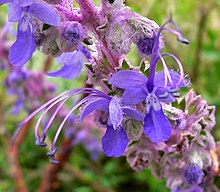Trichostema lanatum
| Trichostema lanatum | |
|---|---|

| |
| Scientific classification | |
| Kingdom: | Plantae |
| Clade: | Tracheophytes |
| Clade: | Angiosperms |
| Clade: | Eudicots |
| Clade: | Asterids |
| Order: | Lamiales |
| Family: | Lamiaceae |
| Genus: | Trichostema |
| Species: | T. lanatum
|
| Binomial name | |
| Trichostema lanatum | |
Trichostema lanatum, the woolly bluecurls,[1] is a small evergreen shrub or sub-shrub native to arid coastal chaparral regions of California down to the northern tip of Baja California.
Trichostema lanatum is many-branched and grows to 1.5 m (5 ft) tall, with narrow, pointed green leaves. The smooth-petaled blue flowers are borne in dense clusters, with the stem and calyces covered in woolly hairs of blue, pink, or white. Flowers are present from March to June.[2]
Spanish explorers in California called the plant romero, the Spanish term for rosemary, and that common name is still sometimes used.[3]
Uses
[edit]Trichostema lanatum is cultivated as an ornamental plant, and several cultivars have been developed.[3] It attracts hummingbirds and bumblebees.[4]
It is aromatic and glandular.[clarification needed] Native Americans used it for a variety of medicinal and other purposes.[5]
Its leaves and flowers make a flavorful tea.[3]
Indigenous medicinal use
[edit]Trichostema lanatum was incorporated[clarification needed] by the Chumash to help facilitate the healing process of menstruation and birth.[6] When tested against an E.Coli ▵tolC mutant, woolly bluecurls (Trichostema lanatum) exhibited anti-bacterial properties.[7][8] Studies have also shown anti-inflammatory properties against pro-inflammatory cytokine TNF-ɑ and anti-bacterial properties against macrophages and gram-postivie bacteria, corresponding with the use of woolly bluecurls (Trichostema lanatum) as a disinfectant and treatment for rheumatism by the Chumash peoples of California.[9]
Trichostema lanceolatum was used by California Indigenous tribes in the form of tea or crushed leaves to treat a range of ailments including common olds, body aches, skin disorders, digestive problems, and malaria.[10] Trichostema lanceolatum and Trichostema lanatum are both a part of the Lamiaceae family. They differ in smell, smell, and location found.[11][12] Indigenous tribes used Trichostema lanatum to treat the same ailments as Trichostema lanceolatum.[10] Woolly bluecurls (Trichostema lanatum) and other native plants have historically been used by Indigenous peoples in a holistic approach to medical care, which typically considers patient health and well-being at the intersection of biology, psychology, and culture, and manipulating the biochemical properties of native plants to treat the ailment.[13]
Future studies of woolly bluecurls and other plants used by Indigenous peoples for medicinal purposes will need to focus on the use of such plants in a broader cultural system of care. Such work can be challenging, given the historical, systematic erasure of Indigenous wisdom that has been a primary function of settler colonialism.
References
[edit]- ^ NRCS. "Trichostema lanatum". PLANTS Database. United States Department of Agriculture (USDA). Retrieved 14 December 2015.
- ^ "Calflora: Trichostema lanatum". www.calflora.org. Retrieved 2017-06-16.
- ^ a b c Rogers, D. (2001). Romero or Woolly Blue Curls. Double Cone Quarterly.
- ^ Santa Monica Mountains Plant of the Month Archived 2010-11-30 at the Wayback Machine
- ^ Ethnobotany
- ^ Adams, James D.; Garcia, Cecilia (March 2006). "Women's Health Among the Chumash". Evidence-Based Complementary and Alternative Medicine. 3 (1): 125–131. doi:10.1093/ecam/nek021. ISSN 1741-427X. PMC 1375244. PMID 16550233.
- ^ Allison, Brittany J.; Allenby, Mark C.; Bryant, Shane S.; Min, Jae Eun; Hieromnimon, Mark; Joyner, P. Matthew (2017-03-19). "Antibacterial activity of fractions from three Chumash medicinal plant extracts and in vitro inhibition of the enzyme enoyl reductase by the flavonoid jaceosidin". Natural Product Research. 31 (6): 707–712. doi:10.1080/14786419.2016.1217201. ISSN 1478-6419. PMID 27482826. S2CID 45752002.
- ^ Fleming, Matthew (2014-03-21). "Extracts of Trichostema lanatum inhibit the growth of gram-positive bacteria and an Escherichia coli ΔtolC mutant strain". Seaver College Research and Scholarly Achievement Symposium.
- ^ Fleming, Matthew C.; Hester, Victoria; Allison, Brittany J.; Foster, Majie C.; Nofziger, Donna; Joyner, P. Matthew (2018-03-21). "Immunomodulatory and Antibacterial Properties of the Chumash Medicinal Plant Trichostema lanatum". Medicines. 5 (2): 25. doi:10.3390/medicines5020025. ISSN 2305-6320. PMC 6023444. PMID 29561753.
- ^ a b "USDA Plants Database". plants.usda.gov. Retrieved 2023-12-18.
- ^ "Plant of the Month Page". Santa Monica Mountains Trails Council. Retrieved 2023-12-18.
- ^ "bluecurls (Genus Trichostema)". iNaturalist. Retrieved 2023-12-18.
- ^ Koithan, Mary; Farrell, Cynthia (2010-06-01). "Indigenous Native American Healing Traditions". The Journal for Nurse Practitioners. 6 (6): 477–478. doi:10.1016/j.nurpra.2010.03.016. ISSN 1555-4155. PMC 2913884. PMID 20689671.
External links
[edit]- Trichostema
- Flora of California
- Flora of Baja California
- Natural history of the California chaparral and woodlands
- Natural history of the California Coast Ranges
- Natural history of the Peninsular Ranges
- Natural history of the Santa Monica Mountains
- Natural history of the Transverse Ranges
- Plants used in traditional Native American medicine
- Bird food plants
- Garden plants of North America
- Drought-tolerant plants
